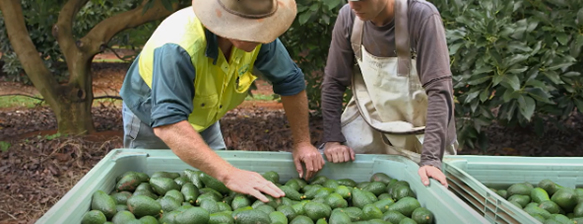NQ Shepard Season – Staying ahead of the game

The issues
The North Queensland Shepard harvest is facing some key challenges and opportunities in relation to fruit quality. Your actions now can limit and even negate these impacts.
Continuous wet weather in December and January, and dealing with a double fruit set, are the key challenges.
The prolonged wet weather means that rots are more likely because orchard sprays were probably less effective than normal. Also waterlogging has caused poorer tree health which impacts fruit robustness.
These points were reiterated by representatives from Costa Group, Rockridge Fresh and The Avolution at the recent Pre-season NQ and CQ Quality Webinar hosted by AV22011 project. A number of opportunities to manage the challenges were discussed.
Your actions
Being proactive even before picking starts can keep you ahead of the game.
Retention samples
Taking representative fruit samples on a block basis and allowing them to ripen at 20°C before assessing rot levels provides valuable insights and can help inform your harvest and marketing plans. It’s recommended to continue to keep library trays as the season progresses for the same reasons.
Maturity testing
Plan before you pick. Sampling fruit by block and conducting maturity testing again provides evidence useful for determining when and where to commence harvesting. This is even more critical because of the double fruit-set in North Queensland. For maturity testing instructions refer to the Maturity and Dry Matter Testing guide located on the BPR.
Maturity monitoring during February 2023 found that 30% of North Queensland Shepard were below the maturity standard. Immature fruit are more prone to developing post-harvest rots and disorders. The sale of immature fruit also causes poor consumer eating experience and leads to them abandoning avocado purchases for weeks. Continue to monitor maturity after you commence harvest.
Don’t mix fruit from sick trees with healthy
Excessive rain has caused waterlogging and individual and patches of sick trees. The robustness of their fruit is compromised. Avoid mixing fruit from sick trees with fruit from healthy trees. Increase your picker supervision where possible.
Post-harvest treatment and dispatch temperature
If a post-harvest fungicide is registered for your market, ensure that it is applied effectively (e.g. within 24 hours of picking).
Ensure your dispatch temperature for Shepard is 7°C. Insist that transport arrives pre-cooled and set temperature is maintained at 7°C. Use a “real-time” temperature logger in your consignments if there are doubts about the effectiveness of the cool chain.
Minimising time in the supply chain
Retail monitoring data shared on the Pre-season NQ and CQ Quality Webinar show that fruit taking 10-15 days from packing to purchase at retail may have up to 2% rots, while 25-day old fruit had 16% rots. Pick and pack to order to prevent fruit from sitting around somewhere in the supply chain and losing shelf-life.
Regularly talk with your marketers and ripeners
Share your knowledge on expected fruit behaviour with your marketers so that they can target the best outlets for fruit of varied robustness to maximise consumer experience. Seeking feedback from the other end of the supply chain will also provide you with insights on how measures you are taking are working to enhance quality.
Wait the required time after rain
Picking wet fruit decreases fruit quality, both internally and externally. Wet fruit are more susceptible to mechanical abrasion and lenticel damage, which promotes the development of postharvest rots. After heavy rain (>20mm in 12 hours) delay harvest for 48 hours. After any rain (<20mm in 12 hours) delay harvest for 24 hours. The roll test may also be used on Shepard fruit depending on the skin texture of your samples.
For further information on supply chain quality monitoring contact John Agnew from the Queensland Department of Agriculture and Fisheries (john.agnew@daf.qld.gov.au) or Anne Larard (idm@avocado.org.au) from Avocados Australia.
This article appears as part of the 8 February 2024 edition of Guacamole (AAL’s enewsletter).
Date Published: 07/02/2024